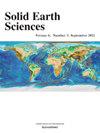Geospatial assessment of groundwater vulnerability to pollution using the DRASTIC and AHP model in flood-affected area, Nowshera, Pakistan
IF 2
4区 地球科学
Q3 GEOSCIENCES, MULTIDISCIPLINARY
引用次数: 0
Abstract
The frequency and intensity of disastrous floods are increasing globally due to climate change. Floodwaters can infiltrate open-dug wells, boreholes, and aquifers, contaminating groundwater. Additionally, anthropogenic activities such as agriculture and industrial processes significantly contribute to groundwater pollution. District Nowshera, located downstream in the Kabul River Basin, faced severe impacts from catastrophic floods in 2010 and 2022, highlighting the serious threat to groundwater vulnerability in the region. The current research is attributed to assessing the aquifer vulnerability to pollution using the DRASTIC and analytical hierarchy process (AHP) models in Nowshera. Several parameters, such as depth to groundwater, Net recharge rate, aquifer media, soil media, topography, the impact of the vadose zone, and conductivity of the aquifer, have been evaluated. Weights and rating analysis for these parameters have been done using the standard methodology of the DRASTIC and AHP approach. The final vulnerability maps produced for the study area were divided into five groundwater-vulnerable zones. The DRASTIC results categorized the study area as very low, which covers an area of 278 km2, low 460 km2, moderate 543 km2, high 355 km2, and very high 90 km2. In AHP results, a very highly vulnerable zone covers an area of 233 km2, more than the DRASTIC results. The results have been validated with the concentration of nitrate, sulfate, and total dissolved solvent water quality parameters. This study presents a straightforward method to assess groundwater pollution vulnerability, provides valuable insights for policy and decision-makers in managing groundwater pollution, and identifies suitable sites for landfill disposal.
基于DRASTIC方法和AHP模型的巴基斯坦瑙谢拉洪灾地区地下水污染脆弱性地理空间评价
由于气候变化,全球灾难性洪水的频率和强度正在增加。洪水可以渗入露天水井、钻孔和含水层,污染地下水。此外,农业和工业过程等人为活动对地下水污染也有重大影响。位于喀布尔河流域下游的瑙谢拉区在2010年和2022年遭受了灾难性洪水的严重影响,凸显了该地区地下水脆弱性面临的严重威胁。目前的研究是利用DRASTIC方法和层次分析法(AHP)对Nowshera含水层的污染脆弱性进行评估。几个参数,如地下水深度,净补给率,含水层介质,土壤介质,地形,渗透带的影响,以及含水层的电导率,已经进行了评估。使用DRASTIC方法和AHP方法对这些参数进行了权重和评级分析。为研究区绘制的最终脆弱性图被划分为五个地下水脆弱区。DRASTIC方法将研究区划分为极低区(278 km2)、低区(460 km2)、中区(543 km2)、高区(355 km2)和极高区(90 km2)。AHP结果显示,高度脆弱区面积为233 km2,高于DRASTIC结果。用硝酸盐浓度、硫酸盐浓度和总溶解溶剂水质参数对结果进行了验证。本研究提供了一种简单的方法来评估地下水污染的脆弱性,为政策和决策者管理地下水污染提供了有价值的见解,并确定了合适的填埋处置地点。
本文章由计算机程序翻译,如有差异,请以英文原文为准。
求助全文
约1分钟内获得全文
求助全文
来源期刊

Solid Earth Sciences
GEOSCIENCES, MULTIDISCIPLINARY-
CiteScore
3.60
自引率
5.00%
发文量
20
审稿时长
103 days
 求助内容:
求助内容: 应助结果提醒方式:
应助结果提醒方式:


